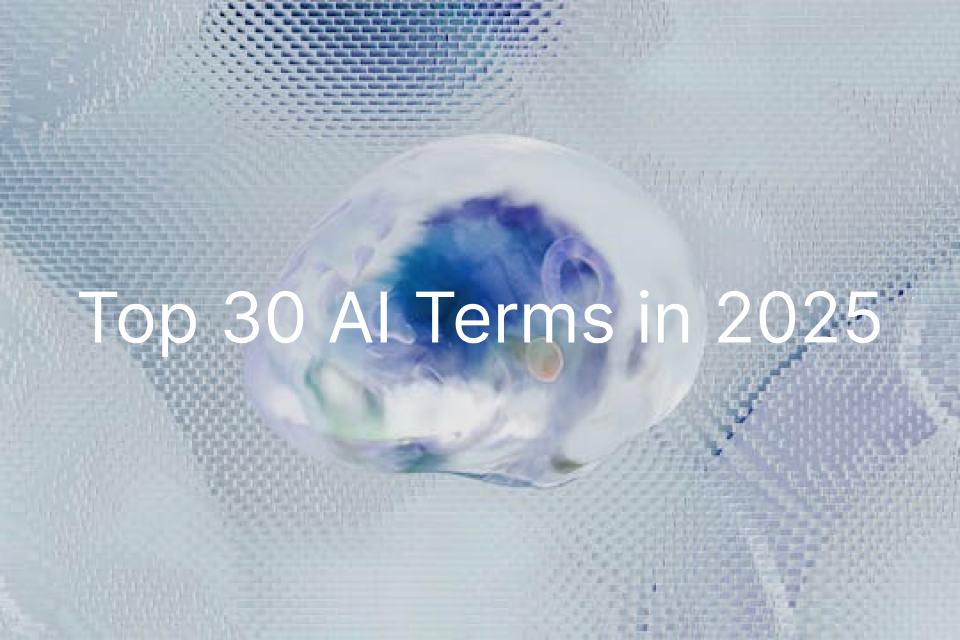Top 30 AI Terms You Need to Know for 2025

TABLE OF CONTENTS
The AI revolution is accelerating, and so is the language that defines it. To stay ahead in conversations shaping our future, mastering these essential terms is a must. This expanded guide covers the most influential buzzwords dominating the AI landscape today, ranked by their current relevance.
Dive in and become an AI insider!
1. Generative AI (GenAI)
Still topping the charts, Generative AI is all about creation. These models produce brand-new content like text, images, code, or audio, rather than just analyzing existing data. It’s the technology fueling the current creative boom in AI.
2. Large Language Models (LLMs)
The powerhouse behind much of GenAI, LLMs are AI models trained on vast amounts of text data. Their primary function is to understand, generate, and process human language, making them the brains behind conversational AI and sophisticated writing tools.
3. GPT (Generative Pre-trained Transformer)
GPT is a family of large language models developed by OpenAI. These models are pre-trained on massive datasets and use the Transformer architecture to understand and generate human-like text. GPT models, such as GPT-3 and GPT-4, have set new standards in natural language processing, powering chatbots, content creation tools, and more.
4. AI Agent
Moving beyond simple commands, an AI Agent is an AI system designed to perceive its environment, make decisions, and autonomously take actions to achieve specific goals. Think of them as independent problem-solvers in the AI world.
5. Prompt Engineering
This is the art of talking to AI effectively. Prompt engineering is the skill of crafting the perfect input (a “prompt”) for AI models, especially LLMs, to guide their output and get exactly the results you want. It’s crucial for unlocking AI’s full potential.
6. Hallucination (in AI)
When an AI “hallucinates,” it generates information that sounds perfectly plausible but is actually incorrect, nonsensical, or made up. It’s a significant challenge, particularly with LLMs, and a major focus for improving AI reliability.
7. Retrieval-Augmented Generation (RAG)
To fight against AI hallucinations, RAG combines an LLM with a retrieval system. Before generating a response, the AI pulls relevant, factual information from a specific knowledge base, making its answers more accurate and verifiable.
8. Multimodal AI
This powerful AI can understand and process information from multiple types of data at once—like text, images, audio, and video. Multimodal AI allows for richer, more human-like interactions and enables diverse applications.
9. Fine-tuning
Want to tailor an AI model for a specific job? Fine-tuning lets you take a pre-trained AI model (like a general LLM) and train it further on a smaller, specialized dataset. This adapts the model to your particular task or domain, making it highly effective.
10. Responsible AI
As AI becomes more integrated into our lives, ensuring its ethical development and use is paramount. Responsible AI is an umbrella term covering fairness, transparency, accountability, and the overall beneficial deployment of AI systems.
11. AI Safety
This field focuses on preventing potentially catastrophic outcomes from advanced AI systems. AI safety research addresses critical issues like unintended consequences, misuse, and maintaining control over highly capable AI.
12. AI Governance
Who sets the rules for AI? AI governance refers to the frameworks, policies, and regulations put in place to guide the development and use of AI in a way that aligns with societal values and legal requirements.
13. Explainable AI (XAI)
Ever wonder why an AI made a certain decision? Explainable AI (XAI) involves techniques that make the outputs and reasoning of AI systems understandable and interpretable to humans. It’s key for building trust and ensuring accountability.
14. Artificial General Intelligence (AGI)
The holy grail of AI: AGI refers to a hypothetical type of AI that possesses human-level cognitive abilities across a wide range of tasks, unlike the specialized AI we have today. It’s a concept that sparks a lot of discussion about AI’s ultimate potential.
15. Diffusion Models
These are the wizards behind many stunning AI-generated images. Diffusion models create data by starting with random noise and gradually “denoising” it until a clear, high-quality image or other output emerges.
16. AI Copilot
Think of an AI Copilot as your intelligent assistant. It’s an AI system designed to work alongside a human, augmenting their capabilities, automating routine tasks, suggesting solutions, and boosting productivity in various fields like coding or writing.
17. Tokens
The fundamental units of text that LLMs process are called tokens. A token can be a whole word, part of a word, a punctuation mark, or even a single character. Understanding tokens is essential for managing LLM input/output limits and costs.
18. Context Window
The context window is basically an LLM’s short-term memory. It defines the maximum amount of text (in tokens) that the AI can “remember” or consider at any given time when generating a response, allowing for longer, more coherent conversations.
19. Mixture of Experts (MoE)
In a Mixture of Experts (MoE) neural network, different “expert” sub-networks specialize in different aspects of the data. A “gate” network then determines which expert(s) should handle a particular input, making very large AI models more efficient.
20. Synthetic Data
Synthetic data is artificially generated data that mimics the statistical properties of real-world data without containing any actual personal information. It’s invaluable for training AI models when real data is scarce, sensitive, or too expensive.
21. Reinforcement Learning (RL)
This is how AI learns through trial and error. In Reinforcement Learning, an AI agent performs actions in an environment and receives rewards or penalties, allowing it to learn complex behaviors and achieve goals, like in game playing or robotics.
22. Machine Learning (ML)
A core branch of AI, Machine Learning focuses on developing algorithms that allow computers to learn from data without being explicitly programmed. It’s the foundation for many AI applications.
23. Deep Learning (DL)
A subset of Machine Learning, Deep Learning uses multi-layered neural networks (often called “deep” neural networks) to learn complex patterns from vast amounts of data. This is what powers advanced image recognition and natural language processing.
24. Neural Network
Inspired by the human brain, a Neural Network is a computing system made up of interconnected “nodes” or “neurons” that process information. They are the building blocks of deep learning models.
25. Overfitting
In training AI models, overfitting occurs when a model learns the training data too well, including its noise and random fluctuations. This makes the model perform poorly on new, unseen data, as it struggles to generalize.
26. Transfer Learning
Transfer Learning involves taking a pre-trained model (one already trained on a large dataset for a general task) and repurposing it for a different, but related, task. It saves significant time and computational resources.
27. Embeddings
Embeddings are numerical representations (vectors) of text, images, or other data that capture their meaning and relationships. AI models use these to understand and process data efficiently.
28. Vector Database
A Vector Database is optimized for storing, managing, and searching vector embeddings. They are crucial for applications like RAG and recommendation systems, enabling fast similarity searches.
29. Data Augmentation
To increase the amount and diversity of training data, data augmentation involves creating new data from existing data by making small, strategic modifications (e.g., rotating images, synonym replacement in text).
30. Automated Decision-Making (ADM)
Automated Decision-Making refers to systems that make decisions with minimal human intervention, based on algorithms and data. This is increasingly common in areas like loan approvals or content moderation.
That’s a lot of cutting-edge concepts! With this vocabulary, you’re now better equipped to navigate the fast-evolving world of AI. The more familiar you are with these terms, the more clearly you’ll see both the incredible opportunities and the critical challenges AI brings.
Which of these terms are you most curious about? Let us know in the comments!


